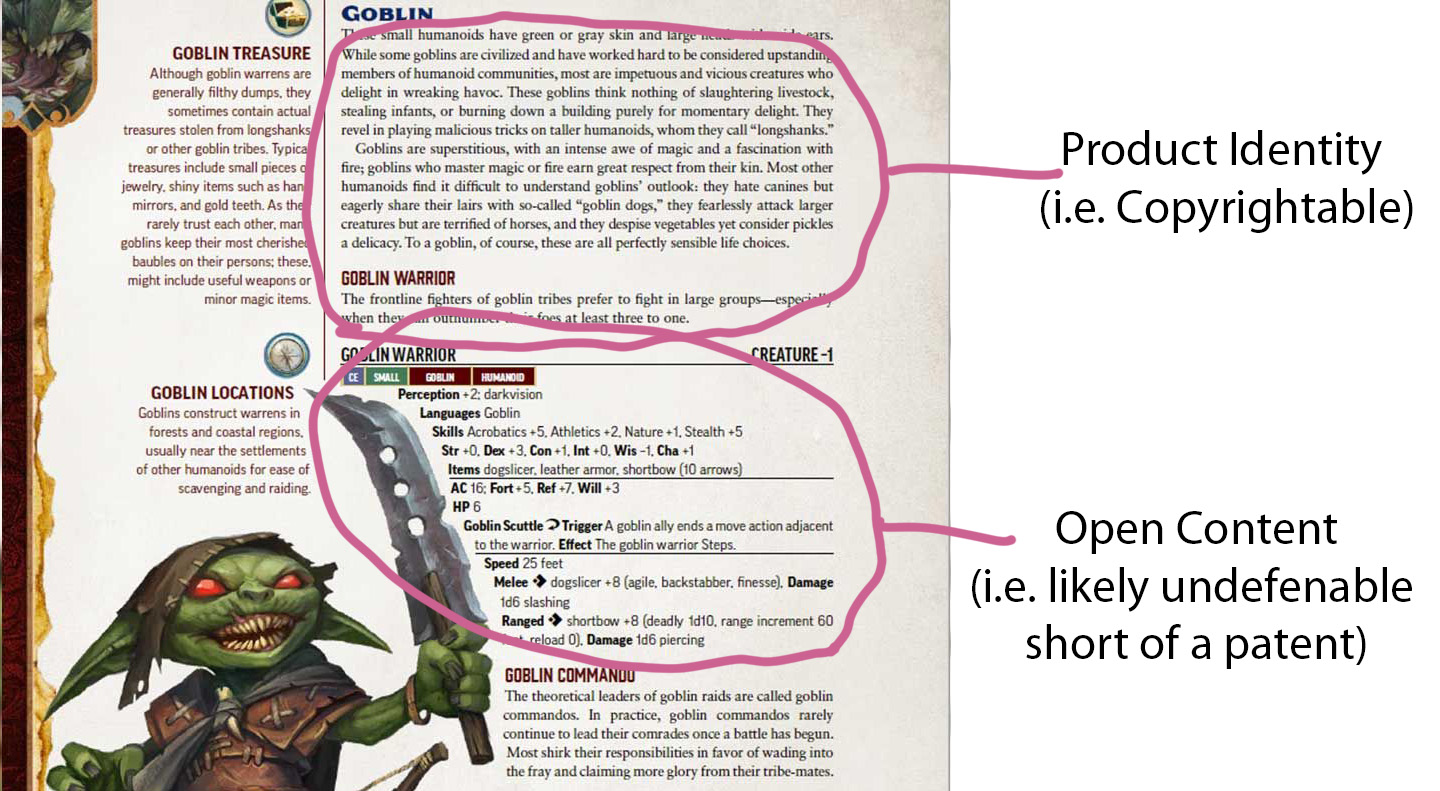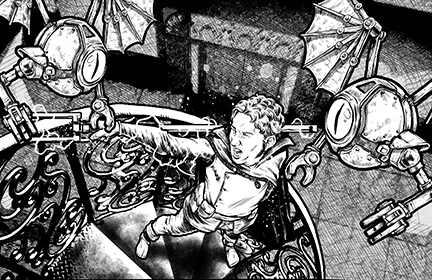I think several roleplaying games don’t get the power of iconic characters or iconics. While I’m a firm believer that a good roleplaying game is a tool for other folks to tell their stories with a group of friends, iconics do work to focus on understanding the game, its tone, and assumptions. During system playtesting, iconics give designers a chance to present both baseline and new exciting rules elements. Plus, if the iconics are done right, they offer an array of excitement to players with different play styles. Lastly, folks love a good character. They either want to inhabit it, learn more about it, and often both.
In short, iconics give focus to games with loose boundaries.
While the iconics were not the first thing I designed for Delve (the base underlying action economy, the basic resolution and challenge math, and the character progression and adversary building were all the first things I designed), I knew that as the design started to take focus, I would need them. The next step involved running the game for people, not just my friends, but people out in the wild, and the best way to do that was to run it at conventions and other events.
Here’s some professional advice when running a new game at a show: make it as easy on the players as possible and always give them a chance to pursue more rules than they might need, but none that they don’t need. For both of those reasons, as easy as character creation is in Delve (it has five steps and some optional choices for your character’s story), it’s better to give them a host of premade characters in a robust character pack. That packet may have hinted at the game’s deeper structures, but its primary goal is to give them an easy way to figure out what their character can do and some necessary information on who they are. These anchor points allow them to flow seamlessly into a game they don’t yet know.
For reasons both historical and strange, when running most roleplaying games at an event, you should function with three or four players, but have no more than six. Being able to perform with three or four players is great for smaller shows or larger ones where learning new games is not the focus. It means there’s a greater chance your game will go off. More than six at a table and chaos can reign. While skilled gamemaster running a system that both they and their players know can function with greater numbers of players, trying to teach a new game to more than six people at a time requires the patience of a saint. I ain’t no saint. My guess is neither are you. The odds are just against it.
I needed six iconics. I only had four classes at the start (priest, rogue, warrior, and wizard) and four people (elf, dwarf, halfling, and human), but that worked for me rather than against me. It allowed me to showcase that you could have two very different priests, warriors, humans, and dwarves. Of course, those were just the overlaps I chose; I was confident that the system could create many different expressions of both the classes and the people. Let’s say the odds were for it. In the end, six, four, and four were perfect for multiple goals design-wise, the next step was to make them interesting.
The first iconic came to my mind after I visited a very posh and populated games store, restaurant, bar, and hang out in the Seattle area (pre-Covid, of course). I went on Sunday mornings to hang out with friends, paint minis, then get some lunch and a beer before getting ready for the Monday start to a corporate workweek. Families and younger people inhabited the place on Sundays, and there were always various games going on. One Sunday, I spied a young lady, maybe in her mid-teens, checking out a game of D&D or Pathfinders (I forget which) played by a tight-knit group maybe a smidge older (except the GM, who was a lot older) than she was. Everyone was laughing and having a good time, and the young lady’s body language made it clear to me that she wanted to join. She was also shy.
I remember being her age. I remember being that person in the corner within a massive back room of the Penrose Library watching slightly older folks having fun in the way I wanted to, and not feeling welcome.
I wanted to make at least a few characters that would be welcoming to that young lady.
See, back in the days of my youth, RPGs were dominated by misfit young men. And I mean that in the best and worst possible way. We didn’t fit in, most of us didn’t want to, and that either bred a tolerance and greater acceptance or created bitterness toward other people. Or strangely, both. We all tended to deal awkwardly with folks outside our group wanting to join the fun. As young men, with our hormones alight (though we had no clue where the fire was burning from), women who played were either interested girlfriends or young woman to be made girlfriends. Added to the fact that D&D and similar games were weird, possibly satanic, and filled with young men who took showers sometimes only by accident, most young women steered clear. And those who did were either white knighted, talked down to, or otherwise treated poorly and coerced to play the cleric.
My first iconic is what I imagined the young woman hovering around the table might want to play. She wasn’t anyone’s cleric. She wanted to do cool shit. She wanted to be a badass. She would love to have a dog.
I have no idea what that young lady wanted to play. I was making this up. But I was willing to bet many people would love to play that character. Hell, I wanted to play that character, mostly if she was full of kind-hearted, but still a bit larcenous, punky charm. And that’s how Ez and her faithful hound Tojo found genesis.

Since unleashing this pair onto game tables at every convention I could muster, she has worked nearly flawlessly. Everyone who plays her comes under her specific charm. The young and the seasoned veterans of RPG have found the duo fun, dynamic, and a breeze to play. Of course, what I’m showing now is after dozens of iterations. Good ideas and intents rarely spawn perfection right off the bat, but being the first of my iconics, Ez and Tojo are near and dear to my heart, and I’ve been pleased by the way these two have grown and become more solid within Delve’s play.
What’s Next?
Over the pandemic, I’ve been doing a great deal of work on Delve. I’ve run several online games at virtual conventions and outside of it, and I’ve been working on the main draft of the rules and some limited drafts. This past weekend, I unleashed full PDFs of the six iconic player packs over at the Delve Patreon, available at both the Delver and Lurker levels. I’m also working on creating two preview PDFs for Delvers at that site.
The first is the Delve Iconic Pack. This PDF will feature not only the iconics, but the expanded rules for playing the game, all the supplementary information for those rules, and information on how to level the iconics up to 3rd level.
The second is the Classic Monster Bestiary, which presents dozens of monster and hazards for the game, spells that some of those monsters use, magic items that they use and that can be handed out as treasure, as well as all the supplementary material needed to understand and run those threats. This packet also provides information on encounter design and a scheme for running a dungeon under a moathouse if one is so inclined.
With these two packets, others will be able to run Delve for their group. I’m in the steps of finalizing the Classic Monster Bestiary, and I’m hoping to get the Delve Iconic Pack done in mid-October, sooner if I can finagle it.
As for online games, I’m running Delve: Under the Moathouse, which I ran at Founders & Legends III this past July, at virtual HawaiiCon this Thursday (starting at 5 p.m. Hawaii time or 8 p.m. Pacific). I’ll also be running that event at Autumn Revel I (exact day and time TBD, but that event runs October 9-12), and GameholeCon (Friday, November 6 at 2 p.m Madison time or noon Pacific). I’m hoping to add another event to both Autumn Revel and Gamehole Con, but if that happens I’ll provide more information on those events at a later date. These are all virtual events that will run on Roll20 and Zoom, and all of them will be recorded.
I hope some of you are able to join me for those events.
Interesting Things
Anyone who knows me knows that I’m not only a reader, but that my reading tastes are fairly…well…eclectic. I’m usually reading at least one fiction and one non-fiction book at any time. My current read for non-fiction is Irresistible: The Rise of Addictive Technology and the Business of Keeping Us Hooked by Adam Alter. And I highly recommend this book for those interested in the subject and especially for game designers. I’m a little over half done with the book and it is an eye-opening critique on tech and game addition, why it’s there, and how it is done. It’s also well-written, nearly addictive itself, and very hard to put down.
Just don’t use its insight for the evil, my friends.





Leave a Reply